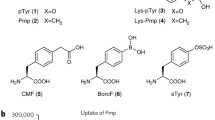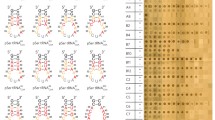Abstract
Biosynthetic incorporation of tryptophan (Trp) analogues in recombinant proteins using an E. coli Trp auxotroph expression host is limited to analogues modified with a small substituent like a fluoro atom or a hydroxyl or amine group. We report here the efficient incorporation (>89 %) of chloro- and bromo atoms containing Trp analogues in alloproteins at high expression levels using a Lactococcus lactis Trp auxotroph strain. This result was only obtained after coexpression of the enzyme tryptophanyl-tRNA synthetase (TrpRS) of L. lactis, an enzyme believed to show a more relaxed substrate specificity than TrpRS from E. coli. Chloro- and bromo-Trps are attractive intrinsic phosphorescence probes as these Trp analogues are much less sensitive for quenchers in the medium, like oxygen, than Trp. Coexpression of TrpRS was also essential for the biosynthetic incorporation (94 %) of the Trp analogue 5,6 difluoroTrp. This makes our expression system ideally suited to generate a set of methyl- and fluoro-substituted Trp analogue-containing alloproteins in high yield for investigating the involvement of the Trp residue in cation-pi or pi–pi interactions. Taken together, the presented Trp auxotroph expression system features the most relaxed specificity for Trp analogue structures reported to date and gives a high alloprotein yield.






Similar content being viewed by others
References
Blaser G, Sanderson MJ, Batsanov SA, Howard AKJ (2008) The facile synthesis of a series of tryptophan derivatives. Tetrahedron Lett 49:2795–2798
Broos J, Gabellieri E, Biemans-Oldehinkel E, Strambini GB (2003) Efficient biosynthetic incorporation of tryptophan and indole analogs in an integral membrane protein. Protein Sci 12:1991–2000
Budisa N (2004) Prolegomena to future experimental efforts on genetic code engineering by expanding its amino acid repertoire. Angew Chem Int Ed 43:6426–6463
Budisa N, Minks C, Alefelder S, Wenger W, Dong F, Moroder L, Huber R (1999) Toward the experimental codon reassignment in vivo: Protein building with an expanded amino acid repertoire. FASEB J 13:41–51
Budisa N, Pal PP, Alefelder S, Birle P, Krywcun T, Rubini M, Wenger W, Bae JH, Steiner T (2004) Probing the role of tryptophans in aequorea victoria green fluorescent proteins with an expanded genetic code. Biol Chem 385:191–202
Datta D, Wang P, Carrico IS, Mayo SL, Tirrell DA (2002) A designed phenylalanyl-tRNA synthetase variant allows efficient in vivo incorporation of aryl ketone functionality into proteins. J Am Chem Soc 124:5652–5653
de Ruyter PG, Kuipers OP, de Vos WM (1996) Controlled gene expression systems for Lactococcus lactis with the food-grade inducer nisin. Appl Environ Microbiol 62:3662–3667
El Khattabi M, van Roosmalen ML, Jager D, Metselaar H, Permentier H, Leenhouts K, Broos J (2008) Lactococcus lactis as expression host for the biosynthetic incorporation of tryptophan analogues into recombinant proteins. Biochem J 409:193–198
Hendrickson WA, Horton JR, LeMaster DM (1990) Selenomethionyl proteins produced for analysis by multiwavelength anomalous diffraction (MAD): a vehicle for direct determination of three-dimensional structure. EMBO J 9:1665–1672
Holo H, Nes IF (1995) Transformation of Lactococcus by electroporation. Methods Mol Biol 47:195–199
Kiick KL, van Hest JC, Tirrell DA (2000) Expanding the scope of protein biosynthesis by altering the methionyl-tRNA synthetase activity of a bacterial expression host. Angew Chem Int Ed 39:2148–2152
Kim W, George A, Evans M, Conticello VP (2004) Cotranslational incorporation of a structurally diverse series of proline analogues in an Escherichia coli expression system. ChemBioChem 5:928–936
Kuipers OP, de Ruyter PG, Kleerebezem M, de Vos WM (1997) Controlled overproduction of proteins by lactic acid bacteria. Trends Biotechnol 15:135–140
Kwon I, Tirrell DA (2007) Site-specific incorporation of tryptophan analogues into recombinant proteins in bacterial cells. J Am Chem Soc 129:10431–10437
Kwon I, Wang P, Tirrell DA (2006) Design of a bacterial host for site-specific incorporation of p-bromophenylalanine into recombinant proteins. J Am Chem Soc 128:11778–11783
Lepthien S, Wiltschi B, Bolic B, Budisa N (2006) In vivo engineering of proteins with nitrogen-containing tryptophan analogs. Appl Microbiol Biotechnol 73:740–754
Milton JG, Purkey RM, Galley WC (1978) The kinetics of solvent reorientation in hydroxylated solvents from the exciting-wavelength dependence of chromophore emission spectra. J Chem Phys 68:5396–5404
Petrovic DM, Leenhouts K, van Roosmalen ML, Kleinjan F, Broos J (2012) Monitoring lysin motif-ligand interactions via tryptophan analog fluorescence spectroscopy. Anal Biochem 428:111–118
Poolman B, Konings WN (1988) Relation of growth of streptococcus lactis and streptococcus cremoris to amino acid transport. J Bacteriol 170:700–707
Ross JBA, Szabo AG, Hogue CW (1997) Enhancement of protein spectra with tryptophan analogs: fluorescence spectroscopy of protein–protein and protein–nucleic acid interactions. Methods Enzymol 278:151–190
Sambrook J, Fritsch EF, Maniatis T, Ford N (1989) Molecular cloning: a laboratory manual, 2nd edn. Cold Spring Harbor Laboratory Press, Cold Spring Harbor
Strambini GB, Kerwin BA, Mason BD, Gonnelli M (2004) The triplet-state lifetime of indole derivatives in aqueous solution. Photochem Photobiol 80:462–470
Terzaghi BE, Sandine WE (1975) Improved medium for lactic streptococci and their bacteriophages. Appl Microbiol 29:807–813
van de Guchte M, van der Vossen JM, Kok J, Venema G (1989) Construction of a lactococcal expression vector: expression of hen egg white lysozyme in Lactococcus lactis subsp. lactis. Appl Environ Microbiol 55:224–228
van der Vossen JM, van der Lelie D, Venema G (1987) Isolation and characterization of streptococcus cremoris Wg2-specific promoters. Appl Environ Microbiol 53:2452–2457
van Hest JC, Tirrell DA (1998) Efficient introduction of alkene functionality into proteins in vivo. FEBS Lett 428:68–70
Vanderkooi JM, Calhoun DB, Englander SW (1987) On the prevalence of room-temperature protein phosphorescence. Science 236:568–569
Veldhuis G, Gabellieri E, Vos EPP, Poolman B, Strambini GB, Broos J (2005) Substrate-induced conformational changes in the membrane-embedded IICmtl-domain of the mannitol permease from Escherichia coli, enzymeIImtl, probed by tryptophan phosphorescence spectroscopy. J Biol Chem 280:35148–35156
Wang L, Brock A, Herberich B, Schultz PG (2001) Expanding the genetic code of Escherichia coli. Science 292:498–500
Wegmann U, O’Connell-Motherway M, Zomer A, Buist G, Shearman C, Canchaya C, Ventura M, Goesmann A, Gasson MJ, Kuipers OP, Robillard G, Leenhouts K (2007) Complete genome sequence of the prototype lactic acid bacterium Lactococcus lactis subsp. cremoris MG1363. J Bacteriol 189:3256–3270
Wong CY, Eftink MR (1997) Biosynthetic incorporation of tryptophan analogues into staphylococcal nuclease: effect of 5-hydroxytryptophan and 7-azatryptophan on structure and stability. Protein Sci 6:689–697
Zhong W, Gallivan JP, Zhang Y, Li L, Lester HA, Dougherty DA (1998) From ab initio quantum mechanics to molecular neurobiology: a cation–π binding site in the nicotinic receptor. Proc Natl Acad Sci USA 95:12088–12093
Acknowledgments
This work was supported by the nanotechnology network NanoNed. The authors are grateful to Biomade Technology Foundation for their support and making available their facilities to carry out part of the work.
Author information
Authors and Affiliations
Corresponding author
Rights and permissions
About this article
Cite this article
Petrović, D.M., Leenhouts, K., van Roosmalen, M.L. et al. An expression system for the efficient incorporation of an expanded set of tryptophan analogues. Amino Acids 44, 1329–1336 (2013). https://doi.org/10.1007/s00726-013-1467-3
Received:
Accepted:
Published:
Issue Date:
DOI: https://doi.org/10.1007/s00726-013-1467-3




